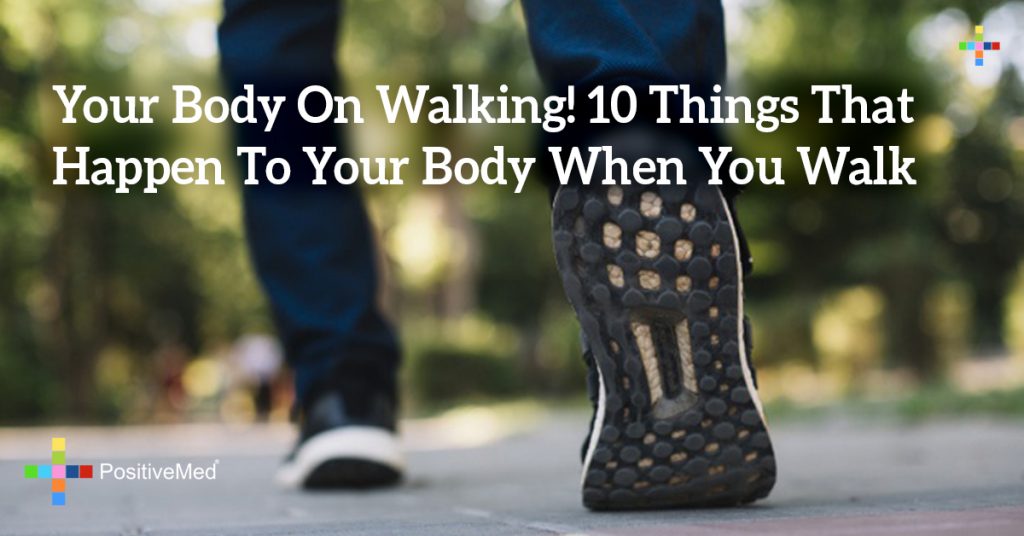
Your Body On Walking! 10 Things That Happen To Your Body When You Walk
SPANISH TRANSLATION: COSAS QUE SUCEDEN A SU CUERPO CUANDO USTED CAMINA
[nextpage title=”…”]
Is the need to start an exercise program weighing heavily on you? Do you want to take steps to improve your health, but need a little nudge? If so, walking is the way to go. Each stride you take renders head-to-toe benefits. Welcome to a tour of the wonders of walking and the exciting timeline of a stroll.
EACH TIME YOU WALK
1. Your body burns fat.
Your body is like a car with two fuel tanks for energy. The first tank holds fatty acids. The second tank contains carbohydrates. When you exercise at low intensity, your body burns fat for energy. As exercise intensity increases, your body uses carbs. Walking is considered low-intensity exercise, ideal for fat-burning. When you walk, 80 percent of your energy is fueled by fat and 20 percent is stoked by carbs.
A University of Tennessee study found that women who walk for exercise have less body fat than those who don’t. Researchers assessed the effect of walking on body composition in 80 women, ages 40-66. Each wore a pedometer throughout the day. The women that logged the most steps had the lowest body fat percentage.
Walk regularly, and watch body fat melt away!
RELATED ARTICLE: By Using This Walking Method You Can Burn Tons of Fat in 8 Weeks!
2. Your bones get stronger.
Bone is living tissue that responds to exercise by increasing in density. The force of muscle tugging on bones stimulates bone cells to reproduce.
Bone mass peaks by age 30, after which bones begin to thin. Weight-bearing exercise shields against bone degeneration, a condition termed osteoporosis. Low bone mass sets the stage for fracture.
A Massachusetts study of post-menopausal women found that 30 minutes of daily walking reduced their risk of hip fracture by 40 percent.
Preserve your precious bones with a daily jaunt.
3. You get happier.
Walking releases, feel-good hormones called endorphins. These potent chemicals increase sensations of pleasure and well-being, acting as natural antidepressants. Endorphins also promote relaxation and relieve pain.
A California State University study showed that the more people walk, the brighter their mental outlook. Researchers assessed the outcome of walking in 37 adults over a period of three weeks. Each participant wore a pedometer to track their daily steps. At the end of each day, subjects completed questionnaires, evaluating mood, depression, and self-esteem. After writing down their ratings, they checked the number of steps they’d clocked on their pedometers. Those who’d walked the most reported feeling happiest.
Advertisement:
[/nextpage] [nextpage title=”…”]
If you’re feeling blue and low, go for a stroll!
RELATED ARTICLE: How Much Walking Do You Need to Lose Weight?
4. You get smarter.
Exercise enhances memory. It speeds blood flow, feeding the brain with the oxygen it needs for energy. Elevated oxygen heightens the brain’s capacity to code and process information. Beneficial enzymes and hormones kick in, boosting brain function.
Walking also stimulates the hippocampus, the brain region involved in learning. When nerve cells in your hippocampus are activated, thinking ability sharpens.
Swedish research shows that physical activity spurs creativity. It triggers the birth of new brain cells, a process termed neurogenesis. A 2014 study published in the Journal of Experimental Psychology revealed that walking reaps fresh ideas. Researchers assessed subjects’ performance before and after walking. They were able to think of 60 percent more uses for an object after a brisk jaunt.
Research conducted at the University of Illinois found that after adults had exercised for 30 minutes, their cognitive abilities improved by 10 percent.
If a problem has you befuddled, go for a walk!
5. Your heart gets healthier.
Walking is a type of aerobic activity that raises heart rate, promoting blood flow to the heart. This strengthens the heart muscle so it doesn’t have to pump as hard and can rest between beats. Blood pressure eases, reducing the risk of heart disease. Strolling also lowers cholesterol.
University of Tennessee research revealed that women who walked two miles daily lowered their blood pressure by 11 points. The study involved 24 postmenopausal women with hypertension, 10 of whom were taking blood pressure medication. About half the women increased their daily walking to two miles over a six-month period. The other half did not change their activity level. The women who exercised saw significant reductions in blood pressure. Six women got their numbers back to normal.
Ward off heart disease with a fun walking program.
RELATED ARTICLE: Walking 101
6. You sculpt muscle.
Walking tones abdominal and leg muscles. Increased muscle mass raises metabolic rate, the speed at which you burn calories.
Strolling nourishes the cushioning tissue between bones called cartilage. Physical impact delivers oxygen and nutrients to cartilage cells, preventing arthritic deterioration.
Ambulation brings your body into better alignment by balancing major muscle groups. Spinal and pelvic muscles are strengthened, relieving back pain.
At Tel Aviv University in Israel, researchers studied the benefits of walking in 52 patients with low back pain. Subjects first completed questionnaires assessing pain level, disability, and walking endurance. Then they participated in a six-week exercise program, walking two to three times weekly. At the end of the study, all subjects reported significant improvement in pain, activity level, and stamina.
[/nextpage] [nextpage title=”…”]
Just picture the great definition you’ll have in your calves, thighs, and abs!
7. You reduce disease risk.
Walking decreases your likelihood of developing diabetes, cancer, and stroke. Physical activity quells inflammation and stress. It also boosts hormone function and immunity. All these mechanisms help your body ward off illness and disease.
Exercise aids your body in processing sugar efficiently, protecting against diabetes.
The National Cancer Institute advises that people who regularly exercise have a 50 percent lower risk of colon cancer. Women who exercise moderately for more than three hours weekly have a 40 percent reduced risk of breast cancer. The prospect of developing uterine tumors is lowered by 45 percent. You’re also less likely to develop lung carcinoma.
A stroke involves rupture or blockage of brain arteries. Impaired blood flow causes brain cells to die in the affected area. Research conducted in 2013 and published in the journal Stroke found that sedentary individuals have a 20 percent higher risk of stroke that people who exercise four times weekly. The study involved over 27,000 Americans over a period of five years. Another 2013 study revealed that walking at least three hours weekly slashes stroke risk more than high-intensity cardio.
Guard yourself against illness and disease with a daily dose of walking.
8. You promote deep sleep.
Walking enhances the effect of melatonin, a sleep hormone. It also triggers the production of the relaxing hormone serotonin. Exercise raises body temperature and the drop in temperature afterward primes you for slumber. When you walk, stress evaporates, so troubling emotions and thoughts don’t bug you at bedtime. You’ll take less time to ease into dreamland, and your sleep will be deeper.
A study published in the journal Sleep revealed that women who exercised for about 3.5 hours per week nodded off faster than those who worked out less frequently.
Become best friends with the Sleep Fairy by walking daily!
RELATED ARTICLE: 3 Ways Sleep Impacts Health
9. You’re less likely to incur dementia.
Did you know that as we age, our brains shrink? Over the course of our lifetime, there’s a reduction in brain volume and the number of nerve cells. This process, known as brain atrophy, is made worse by smoking, obesity, high blood pressure, and diabetes. It causes dementia, characterized by forgetfulness, memory loss, confusion, and poor judgment.
Walking shields you from cognitive impairment. It dashes the risk factors for dementia by 40 percent. By improving circulation to the brain, walking preserves nerve cells. The more you walk, the better you safeguard your brain.
[/nextpage] [nextpage title=”…”]
University of California researchers studied the effect of walking on dementia. The study followed 6,000 women who walked for exercise. Those who logged 2.5 miles a day had slower mental decline than women who walked less than half a mile a week.
Walking is your ammunition against Alzheimer’s disease.
10. You increase your potential lifespan.
Regular walking promotes longevity. A Boston hospital data analysis found that for every minute of exercise, seven extra minutes of life are attained. The research was conducted at Brigham and Women’s Hospital and published in PLOS. The analysis evaluated six studies involving more than 650,000 people over a period of 10 years. Subjects walked briskly for 2.5 hours weekly and gained an average of 3.4 years of life.
Live long and prosper with walking!
RELATED ARTICLE: How The Point Of Longevity, Permanent Healing And Rejuvenation Can Be Accomplished With This Technique
CHRONOLOGY OF A BRISK WALK
To further inspire you, here’s the exciting timeline of a one-hour jaunt.
Minutes 1-5:
Your heart rate and circulation increase. Joint stiffness diminishes as lubricating fluids release. The elevated activity burns five calories per minute versus one calorie per minute at rest. With the escalated need for energy, your body derives fuel from fat and carbs.
Minutes 6-10:
Your heart rate continues to accelerate, ranging from 100 to 140 beats per minute. You now burn six calories per minute. Blood vessels dilate, transporting more oxygen throughout your body and brain.
Minutes 11-20:
Body temperature keeps rising, you begin perspiring, and blood vessels expand to release the heat. As you kick up the pace, you burn seven calories per minute and start to breathe harder. The hormones glucagon and epinephrine increase, directing fuel to muscles.
Minutes 21-45:
You feel both exhilarated and relaxed. Tension melts as endorphins dance. Fat-burn is easing the job of the insulin-producing pancreas.
Minutes 46-60:
As carb stores decrease, you start feeling fatigued. In the cool-down phase of your workout, your heart rate and breathing slow. Calorie burn isn’t as high but will remain greater than your resting metabolism for up to one hour.
For the rest of your day:
You feel great!
THE FAST TRACK TO HEALTH
Walking puts you in the express lane on the highway to better health. Let’s recap all the perks of ambulating:
1. Fat burn
2. Strong bones
3. Sunny mood
4. Sharp mind
5. Healthy heart
6. Toned muscles
7. Enhanced immunity
8. Deep sleep
9. Dementia protection
10. Longer life
Are you pumped to lace up your walking shoes?
[/nextpage]





